| Srl | Item |
| 1 |
ID:
141027
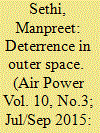

|
|
|
| 2 |
ID:
087448
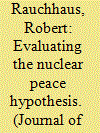

|
|
|
|
|
| Publication |
2009.
|
| Summary/Abstract |
Do nuclear weapons reduce the probability of war? This article quantitatively evaluates the nuclear peace hypothesis. The results indicate that the impact of nuclear weapons is more complicated than is conventionally appreciated. Both proliferation optimists and pessimists find confirmation of some of their key claims. When a nuclear asymmetry exists between two states, there is a greater chance of militarized disputes and war. In contrast, when there is symmetry and both states possess nuclear weapons, then the odds of war precipitously drop. When combined, these findings provide support for the existence of the stability-instability paradox. Evidence suggests that while nuclear weapons promote strategic stability, they simultaneously allow for more risk-taking in lower intensity disputes.
|
|
|
|
|
|
|
|
|
|
|
|
|
|
|
|
| 3 |
ID:
128017
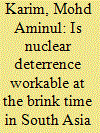

|
|
|
|
|
| Publication |
2014.
|
| Summary/Abstract |
The aim of this paper is to analyze the likely reactions of the nuclear actors, mainly
in South Asia, in any prospective tensed scenario. Nuclear deterrence is generally
being sustained in South Asia since 1971 but a turn of events might suddenly
transform this state to a degree that could prompt the decision-makers to take
hasty and irrational decisions. This paper examines the doctrines, command and
control, safety measures, nuclear terrorism, and above all the strategic stability in
South Asia in order to determine the probability of reaching the brink time. The
paper concludes that even a small-group provocative act may initiate a conventional
showdown to start with, maybe centering on Kashmir or other sensitive issues; it
may then possibly compel the actors to consider the use of nukes.
|
|
|
|
|
|
|
|
|
|
|
|
|
|
|
|
| 4 |
ID:
155058


|
|
|
|
|
| Summary/Abstract |
What do nuclear weapons mean for the stability of the military balance? Mutually assured destruction (MAD) describes a stalemated balance of power where nuclear adversaries possess survivable retaliatory capabilities that ensure neither side can escape devastation in an all-out nuclear war. Moreover, the strong form of this empirical claim, which one might term “deep MAD,” is that mutual vulnerability is an inalterable and unchangeable condition. Drawing from recently declassified primary sources, we test several of deep MAD's premises and predictions on one of its foundational cases: Soviet nuclear policy during the second half of the Cold War. We find that Soviet leaders remained seriously concerned about the nuclear balance even in an allegedly deep-MAD environment where warheads numbered in the tens of thousands. Indeed, Soviet leaders were uncertain that they could indefinitely maintain a secure second strike despite strenuous efforts. The reason for these discrepancies, we argue, is that the nuclear balance is actually more malleable than commonly admitted. The possibility that MAD might one day be escaped meant that US attempts to manipulate the nuclear balance during the latter part of the Cold War could carry political weight, even while MAD was still possible.
|
|
|
|
|
|
|
|
|
|
|
|
|
|
|
|
| 5 |
ID:
019452
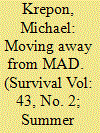

|
|
|
|
|
| Publication |
2001.
|
| Description |
p81-95
|
|
|
|
|
|
|
|
|
|
|
|
|
|
|
|
| 6 |
ID:
068235
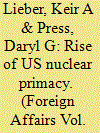

|
|
|
| 7 |
ID:
147046
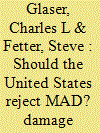

|
|
|
|
|
| Summary/Abstract |
As China invests in its nuclear forces and U.S.-China relations become increasingly strained, questions of U.S. nuclear doctrine require greater attention. The key strategic nuclear question facing the United States is whether to attempt to maintain and enhance its damage-limitation capability against China. The answer is less straightforward than it was during the Cold War, because China's nuclear force is orders of magnitude smaller than the Soviet force was. Part of the answer depends on the military-technical feasibility of the United States achieving a significant damage-limitation capability: What would be the outcome of military competition over the survivability of China's intercontinental ballistic missiles, submarine-launched ballistic missiles, and command and control, and over the effectiveness of U.S. ballistic missile defenses? The answer also depends on the benefits that a damage-limitation capability would provide; these could include contributions to homeland deterrence, extended deterrence, and reassurance of U.S. regional allies. The final piece of the analysis concerns the potential costs of a damage-limitation capability, which could include increased escalatory pressures during crises and growing political tension between the United States and China. A thorough analysis demonstrates that the United States should forgo such a capability because the prospects for preserving a significant damage-limitation capability are poor; the deterrent benefits would be small; and the escalatory and political costs would be relatively large.
|
|
|
|
|
|
|
|
|
|
|
|
|
|
|
|